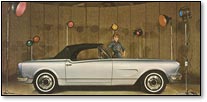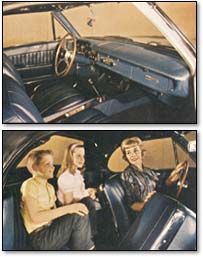
Budd XR-400 Convertible
Budd Company, Detroit, Michigan
Date: 1962 ID: 97.32.1
In 1962 the Budd Company, a long-time supplier of tooling, parts, and bodies to the auto industry, came to American Motors Corporation with an interesting proposition. It was a scheme for modifying Rambler Ambassadors into "...a brand new type of car--one designed specifically to take over a healthy segment of the new car market presently untapped by any American manufacturer." The new car would have a long hood, a short rear deck, bucket seats and a choice of a six or eight cylinder engine. Budd estimated that it could be in production by October of 1963. AMC turned them down.
In April, 1964 Ford Motor Company introduced a very similar car that did "take over a healthy segment of the new car market"--the Mustang. Why did American Motors pass on this chance to reach a new group of buyers? There were probably at least two reasons. First, George Romney, who had carved out a niche for American Motors as a maker of compact cars, left the company in February 1962 to run for governor of Michigan. Romney's replacement Roy Abernethy favored head-to-head competition with the Big Three all across the board. Abernethy probably thought the XR-400 was too small to compete against other sporty compact cars like the Corvair Monza and Pontiac Tempest Le Mans. Another factor may have been cost. The new 1963 AMC line was already a major expense. Jumping into a new market with a new car could be a costly mistake. In the end the XR-400 went back to Budd, the Mustang became a roaring success, AMC was eventually bought out by Chrysler, and auto historians were left wondering, "What if?"
| Budd's prototype was actually built on a shortened two-door 1962 Ambassador chassis. The styling is clean and uncluttered, giving few hints of its Rambler origins. Only the double crease in the beltline, running from front fender to rear fender, is reminiscent of 1962 Rambler styling. The dip in the top of the door, the simulated scoop behind the front wheels, and the hoodline that slopes lower than the front fenders are all classic sports car touches. The engine is a standard Ambassador 327 cu. in. V8 with two barrel carburetor.
The XR-400's interior is in keeping with 1960s sports car practice. The dash holds a full set of instruments--speedometer, tachometer, and gauges for fuel, water temperature, amperes, and oil pressure--and the wood-rim Nardi steering wheel was a highly prized sports car accessory. The automatic transmission was not typical of sports cars, but the shift lever is floor mounted. Upholstery is dark blue vinyl. The rear seat is nicely fitted out, but is useful only for children. Even in the front seat drivers over six feet tall would feel cramped. This limited interior room probably played a major role in convincing American Motors not to pursue production of the car. The manual convertible top folds neatly behind the rear seat, but requires two people to raise and lower it.
|


From Budd Car Company brochure
|
There are a couple of final ironies to the XR-400 story. Budd tried to sell the idea to Ford first. In 1961 Budd combined a 1957 Thunderbird body with a 1961 Ford Falcon chassis to produce a sporty convertible. When Ford turned them down, Budd shifted focus to AMC. Ford, of course went on to base the Mustang on the Falcon chassis. In 1987 American Motors gave up its struggle to remain independent, and was bought out by Chrysler Corporation. Chrysler was headed by Lee Iacocca, who, while at Ford, was the man who pushed the Mustang into production. As Lido himself was fond of saying, in the car business, you either lead, follow, or get out of the way. |

